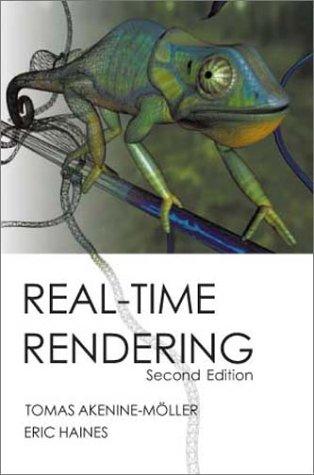|
Real-Time
Rendering (second edition)
Author:
Tomas Akenine-Möller
Publisher: A.K. Peters
ISBN: 1-56881-182-9
Purchasing: [Amazon.Com]
- RRP US$59
Reviewed: 18th September 2002
Front
Cover Shot:

Overview
Real-Time
Rendering, the first edition, was one of the books
that all top graphics programmers would have a
copy of. In 1999 it was one of the
definitive texts on the subject.
Now,
in 2002, the field is radically different,
justifying this expanded and more up to date text
- covering not only the original content, but all
of the latest and greatest innovations and
technologies of the last 3 years.
A
Solid Foundation
The
first edition won many awards (including the
bestseller award from Amazon) and was praised for
being full of both practical information and
theoretical information. 3D graphics, whilst it
has advanced considerably in 3 years, is still
based on the same foundations that Möller and
Haines were writing about in the first edition.
This provides a great starting point for this
book, yet at the same time it also raises the bar
for the acceptable level of a second edition.
The
second edition has been expanded by some 60%, with
several new chapters and all the
corrections/revisions necessary for the original
edition. The new chapters generally deal with the
advanced areas of 3D graphics (API's may be
getting easier/better, but the field just keeps
getting more complicated). We have gained a
significant amount of new text regarding shading
techniques and advanced illumination - two areas
that were almost impossible in real-time at the
time the first edition was written, but are fast
becoming standard now. We also get (mostly
included in the new chapters) coverage of shader
technology - possibly the biggest change in recent
years, and curved/sub-division geometry.
Experience
and Skill
Both
Möller and Haines show a considerable amount of
experience in this field, and a great deal of
theoretical/research knowledge. There are more
references quoted at the end of the book than
there are actual physical pages (846 references to
835 pages).
The
fact that they possess plenty of industry
experience, and obviously enjoy their work, rubs
off on the writing style of the book - it is both
informative and interesting to read.
No
Stone Left Unturned
The
book, albeit relatively small in physical
dimensions does not fail to hit any of the major
areas that make up real-time computer graphics
today. Everything from a full overview of
traditional (and modern) rendering pipelines to
occlusion culling is covered.
The
content is intentionally API independent -
anything you learn in this page will require you
to translate it into a form acceptable/appropriate
to your 3D API of choice. For this point alone it
raises the level of skill and knowledge on the
readers part. You need to be very good, and very
knowledgeable about your API (be it Direct3D or
OpenGL). If you're fairly new to the real-time
graphics scene then this book could prove to be a
challenging read, but if you persevere with it
(and maybe read it along with a book specific to
your API) then it will do you wonders.
It
is a book great for learning, but it also stands
out as a great book for research and reference. If
there are features of graphics that you're not too
familiar with or need to learn about in a hurry
you can pick this book up and get quite a bit of
information about them without having to read the
whole book. Likewise, with the huge reference list
included you can often find the original research
material covering what you're actually trying to
do. Effectively opening gateways to solve your
problem.
Presentation
This
book is quite heavy on text, so expect to do
plenty of reading. Other books of similar content
have had more diagrams to help with the
explanation. This is only a minor point, but for
those of you who prefer a more visual approach to
learning will find it slightly harder going than
some texts.
There
are a considerable number of color plates included
in the book - far more than you'd expect to find:
49 to be precise.
The
book makes heavy use of mathematical notation -
all things considered, graphics programming is
very heavy on mathematics so this is to be
expected. For those of you not completely up to
speed on notation, a summary and overview is give
at the start of the book - but this is revision
and not for first-time learning.
In
Conclusion
Möller
and Haines are back with another top-quality book.
Building on their original success they've
succeeded in improving and refining it to take
into account the latest technological advances.
For those of you who own a copy of the first
edition there is probably plenty in here to
justify purchasing, those without the first
edition should already be contemplating where to
buy the book.
| Good
Things |
Bad
Things |
| •
Covers every major aspect of current 3D
graphics. |
•
Not much mention of non-3D related
graphics work. |
| •
Works brilliantly as a reference book, and
also as a general reading book. |
•
Not much use for beginners. |
| •
Möller
and Haines know what they're talking
about. |
•
Applied Direct3D section is not
particularly relevant anymore. |
| •
An extensive reference list for those who
wish to go further. |
•
Could have been slightly improved with
more diagrams to explain the main text. |
| •
A must have for those who don't have the
first edition. |
|
|

